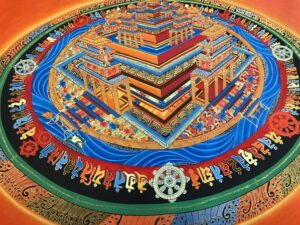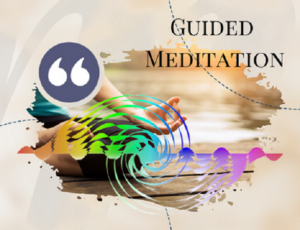Pranayama, Shakti & the Gunas
Chakra activation means you start with breathing practices called Pranayama. Meditation, on the other hand, has quite a few ways you might begin.
Each chakra has its color and a particular number of lotus petals as you may know. The image of a chakra is presented in a lotus for several reasons, one being because the lotus blooms when it is imbued with the power of the sun, and closes when the sun goes down. Similarly, the chakra becomes activated when Shakti (Energy) is present there; otherwise it is dormant.
Similarly, just as a lotus will close when it gets splashed with water, if you drown yourself in excess sensory stimulation (too much guna influence), then likewise the lotus will close.
Muladhara Chakra
Located at the base in the perineum, Muladhara Chakra is pictured with four lotus petals pertaining to the plexus of nadis (nerves and/or energy meridians) found there. Other chakras may have two or sixteen or even a thousand petals. These petals are representative of the varied modes of discrimination relevant to that chakra. Each petal contains a Sanskrit letter pertaining to the modes of awareness. There is also a central bija mantra, that chakra’s core sound or constituent principle. The chakras have a direct correlation with the greater constituents known as tattva, or principles of reality. By performing the proper ritual with that chakra’s bija mantra, the modes of discrimination are revealed to your awareness. Muladhara Chakra is sealed with yellow, representative of the Earth element.
Physics & Metaphysics
The exercise in Chakra awareness and activation is an exercise in energy manipulation and consciousness expansion. You want to make an energy which is sleeping down below, to come awake and rise through to the top. It must be pushed. Gravity, among other things, is keeping it down. You must create a pressure, and maintain that pressure in order that it rise and remain risen.
The discussion of physics and spirituality is often difficult to reconcile together until we acknowledge the totality of the interconnection of existence. Here we are talking at once about physical as well as metaphysical energy. Embodied consciousness is both and thus the earth element, too, contains both. When we talk about moving prana, the life force, through the body, we are also talking about both. Prana is moved using both physical breath via breathing exercises, various physical locks with tongue and other, as well as a visualization and sound.
Prana & the 5 Winds
The body has a circulatory system. All the life fluids and airs circulate and flow. The flow of prana, though practiced in five dimensions, is most precisely coaxed in upward and downward movements. These are the two winds known as Udana and Apana which need not only be vitalized in order to do their jobs properly and give you vigorous health, but also gently cajoled into moving in opposite directions than usual, thereby creating a pressure where the two winds meet and thus stimulating chakra activation.
It’s not enough to go inward with your eye and simply flip a switch. It won’t work. When the energy really awakens and has left its sleeping place in Muladhara, connection with the earth element will dissipate and the samskaras accumulated through numerous births will also shed. You will gain full knowledge of the earth element and at the same time, things of the earth will lose their attraction for you. In other words, vices like greed and similar clingy or overly attached emotions will no longer be a hindrance even while you live a normal life of day to day joy.
Meditation & Patanjali’s Yoga Sutras
Meditation is an impeccable instrument and intricate activity depending on purpose and approach. Patanjali’s Eight Limbs are interesting here in so far as the practice of the yamas and niyamas, the ethical structure, or practice of right living, is a good basis from which to begin to apprehend the detachment of the vices associated with Muladhara Chakra and that phenomenon we often refer to as the closed or inactive chakra. Patanjali’s practices are systematic, helping the practitioner to thoroughly reconcile the 3D of mind even before getting physical with seated postures good for meditation. When these two stages are clear, then he will slowly and gently introduce the breath practices that will allow you to prepare for the sustained concentration and focus activities of dharana and dhyana which will bring you to the first stages of Samadhi, self-realization and/or real meditation.
Personally I’ve found it beneficial to teach a less stoic, much more gentle approach to a meditation practice first, incorporating other aspects of the path and yogic view as suits individual proclivities and interest. Meditation does not need to be a detailed system until unless there is a specific goal one sets out to achieve.
In short, find yourself a comfortable place where you will remain undisturbed, take up any comfortable position, close your eyes and watch. Watch your breath. Watch your thoughts. Witness. Just witness. Know yourself. See first what is what with your current state of being. Observe. Don’t judge it. Just observe it. This is a very good way to begin. You’re starting to be mindful of being embodied consciousness.
After you are able to simply observe, dispassionately, then there are many techniques to control the breath, silence the mind, work with the chakras, bend reality, attain sublime silence, etc., but quiet observation is a very good way to start the process.
Om Namah Shivaya

…is a Saiva Tantrika, Gyana Yogi and founder of Uma Maheshwara Yoga & Ayurveda. David has an MA in Semiotics, lives in Japan with his family and works as a coach in L & D, devoting his time to developing science-based tools and programs that help people reach the fullest potential of the human condition.
Discover more from REAL YOGA
Subscribe to get the latest posts sent to your email.









